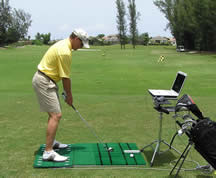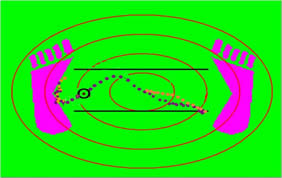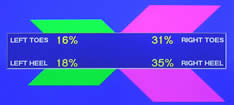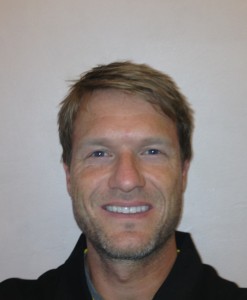| In Part 1 we discussed why an efficient golf swing is born from good physical balance. In Part 2 you self-evaluated your balance and learned a little about how I might assess you in our clinic. Part 3 came with some great FitGolf exercises specific to every part of your swing. The exercises are similar to the tests… they’re supposed to be challenging. Keep them in your library of exercises. My older clients would urge you to do so!
In the final chapter of “Your Guide to Becoming a Balanced Golfer” I need to show you something. It’s called the Dynamic Balance System or DBS for short.
The DBS is that platform you can see the golfer standing on in the picture above. It’s right next to me in the clinic as I type this. It’s then connected to my laptop via cables and a processer. This priceless piece of equipment picks up details concerning your balance and how you’re using balance in your golf swing. Motion-capture video is essential, but where it leaves off, the DBS picks up. This little beauty was developed by Dan Goldstein, a physical therapist and athletic trainer in West Palm Beach, FL. I’ve been using this equipment in my clinic for 10 years. In my experience, the DBS has become one of the quickest and easiest ways for a golfer to look at a simple video monitor and learn from what they see, truly feel it, and immediately implement it. Often times I just get to sit back in my chair and watch my golfers learn. The biofeedback is simple but so effective.
If you want to see what percentage of weight is on your toes and heels at address, this thing does it. If you want to see how much weight you’ve transferred at the top of the swing you just put yourself there and look at the monitor. If you’re curious how much weight you have on your lead side at impact… the DBS can literally answer you by the time you finish your swing and turn around to look at the monitor. If you want to see how one swing you’ve been working on is different than another you can easily compare them. If your instructor has asked you to set up with more weight on your left side when you putt… put yourself on the platform and move around until you’re exactly where you want to be. If you want to see what some of the best tour players do… it’s got that for you too! Once you understand where your instructor wants your weight to be at all points in the swing, the DBS will help you see it and feel it. The key here is to “feel” it. Once you master those balance feels, you will be able to find your way around the golf swing. A great drill is an exercises we call “Feel Your Feet”. In this drill, stand in socks or bare feet…it even works in golf shoes. Your attention needs to be on the pressure you feel in the bottom of your feet. Once you’re aware of the bottom of your feet, shift your weight to the front of the foot…and feel the pressures, and how the toes and muscles of the feet react. Now move your weight to the heels and feel how your feet react. How are they when your weight is on the outside of the feet; how about the inside? Now put the weight on the center of your feet, front to back and inside to out. How does that feel? Really stable is probably your answer. PERFECT!
The goal is to “feel your feet” and how they react to weight on the different parts of your feet. Once you learn that, and couple it with the feedback of the DBS, you will have the skills needed for good foot work during your golf swing. If you’re ready to step on the DBS yourself, FitGolf Performance Centers are staffed with experts to help you. Click here to start looking for a FitGolf Performance Center near you. All the best.
|




